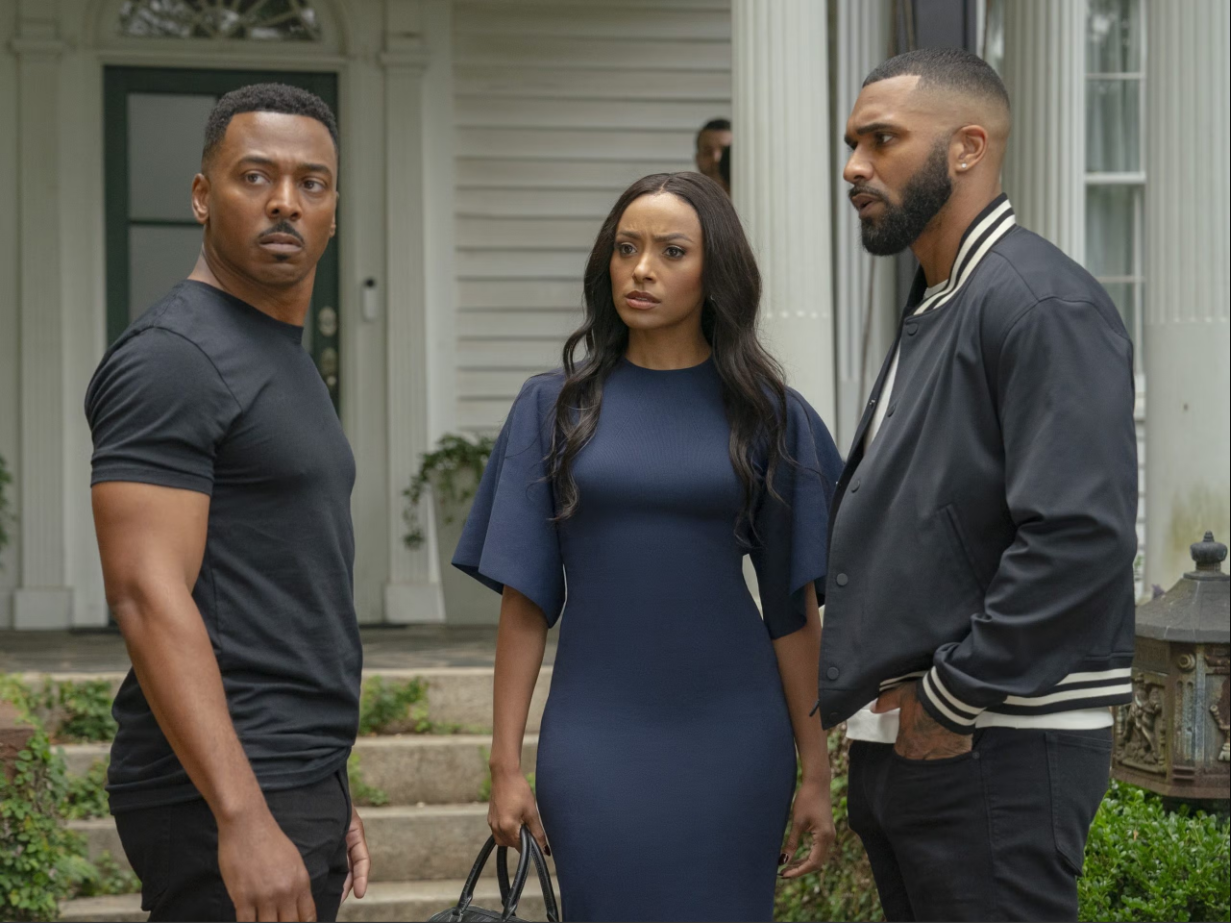RonReaco Lee’s Transformative Performance in Tyler Perry’s Duplicity: A Cinematic Study of Vulnerability and Truth
The Emotional Apex of Duplicity: A Performative and Cultural Analysis
Tyler Perry’s Duplicity, currently streaming on Prime Video, unfolds as a richly layered meditation on deception, loyalty, and the intricate entanglements of familial allegiance. Within this narrative architecture, the film reaches its emotional zenith through the profoundly affecting performance of RonReaco Lee. Portraying Marcus—a man caught between ethical responsibility and psychological unraveling—Lee transcends conventional dramatic portrayal, achieving a level of performative gravitas seldom witnessed in contemporary mainstream cinema.
This analysis explores the emotional, technical, and cultural dimensions of Lee’s most potent scene. It situates his performance within advanced theoretical frameworks of performance studies, investigates his rigorous preparation and immersive techniques, and considers the broader sociocultural implications of emotional expressivity, particularly within representations of Black masculinity. This inquiry is intended for scholars, practitioners, and cinephiles invested in the aesthetics and ethics of emotional authenticity in film.
The Crux of Disintegration: A Scene That Recalibrates Narrative Trajectory
At the narrative core of Duplicity lies a pivotal scene in which Marcus is confronted with an irrefutable betrayal by someone he once trusted implicitly. This moment does not merely propel the plot forward; it fundamentally reconfigures the emotional and thematic topography of the film. With sparse dialogue and strategic cinematography, the camera lingers on Marcus’s face, capturing each tremor, breath, and ocular shift with haunting intensity.
This scene functions as a site of existential rupture. For Marcus, it is a descent into affective disorientation as the foundations of trust and self-conception erode beneath him. For the audience, it is a moment of affective convergence—where spectatorship transforms into identification and shared vulnerability.
During Prime Video’s Roll Playback event, Lee joined castmates Kat Graham, Meagan Tandy, and Tyler Lepley to discuss the filming process. Lee’s reflections, however, offered unparalleled insight into the scene’s emotional architecture.
“I had to descend into an uncomfortable psychological space,” Lee observed. “It wasn’t about delivering lines—it was about inhabiting a wound.”
On set, the atmosphere shifted. Silence assumed a near-sacred dimension—no longer a void but an active presence, a reverent acknowledgment of the moment’s emotional gravitas.
Emotional Methodology: RonReaco Lee’s Immersive Preparatory Praxis
Exemplary performances are rarely the product of chance; they emerge from disciplined craft, deep introspection, and collaborative intentionality. Lee’s preparation for this scene represents a convergence of method acting, affective realism, and dramaturgical precision.
Methodological Pillars of Lee’s Process:
- Affective Memory Integration: Lee drew from personal emotional reservoirs, anchoring his portrayal in authentic lived experience. This technique yielded a performance imbued with psychological realism and emotional texture.
- Strategic Isolation: In the 24 hours preceding the shoot, Lee deliberately withdrew from social interaction to preserve emotional continuity. This self-imposed isolation sustained the intensity required for the scene’s demands.
- Director-Actor Semiotic Collaboration: In partnership with Tyler Perry, Lee meticulously analyzed the scene’s emotional cadence. Every pause, gesture, and tonal modulation was choreographed to resonate with the character’s interior landscape.
“Tyler constructed an environment where vulnerability wasn’t just permitted—it was imperative,” Lee noted. “That kind of creative trust is exceedingly rare.”
Lee’s work in this moment defies simple classification. It is best described as a corporeal embodiment of grief and disillusionment, wherein the distinction between actor and character dissolves into emotional singularity.
Audience Reception as Reflective Echo: Affect, Catharsis, and Cultural Resonance
The cultural and emotional reverberations of Lee’s performance extended far beyond the frame, catalyzing responses of deep empathy and catharsis among viewers and critics alike. His portrayal engendered not mere identification, but affective transference—a visceral resonance with the pain of betrayal and emotional collapse.
Selected Audience Responses:
- “RonReaco Lee should be in every major awards conversation. I felt every fracture in his voice.”
- “This wasn’t acting—it was an exorcism. I had to pause the film and regroup.”
- “That scene reverberated in my bones.”
- “This is the kind of performance that should be dissected in graduate-level acting seminars.”
In a media environment often driven by spectacle and brevity, Lee’s performance demands an emotional deceleration. It insists on reflection, empathy, and unmediated presence.

Contextual Clarifications: A Concise Inquiry into Scene Dynamics
Who is Marcus in Duplicity?
Marcus is a man caught in the dialectic of loyalty and betrayal. His psychological descent encapsulates the film’s central themes of familial obligation and the fragility of trust.
Was the scene improvised?
The dialogue was scripted, but Lee’s delivery was infused with personalized emotional cues and improvisational nuance. The result is a seamless fusion of textual fidelity and spontaneous emotional authenticity.
How did Tyler Perry respond to Lee’s performance?
Perry described the scene as “one of the most unscripted-feeling performances I’ve ever directed.” He praised Lee for channeling a depth of emotional reality that far exceeded the written script.
How many takes were required?
The final take was captured within two attempts. Perry recognized the singular authenticity of Lee’s initial delivery and chose not to dilute its impact through repetition.
Where can the scene be viewed?
This emotionally transcendent moment is featured in Duplicity, now streaming on Prime Video.
Ensemble Dynamics: Interpersonal Alchemy and Emotional Elevation
The emotional resonance of this scene is inextricable from the ensemble’s collective synergy. The cast operated with mutual respect, vulnerability, and creative intentionality—conditions essential for the emergence of emotionally authentic performance.
Kat Graham remarked, “Working with RonReaco, you immediately recognize how fully he commits. His emotional generosity raises the stakes for everyone else.”
Meagan Tandy echoed, “We all stopped acting in that moment—we became witnesses.”
Tyler Lepley added, “The air changed. Everything became more vivid, more essential.”
Such ensemble harmony fosters not only technical cohesion but deep emotional amplification—conditions necessary for the emergence of transcendent performance.
Subverting Tropes: Emotional Vulnerability and Black Masculinity
Mainstream cinema has historically constrained representations of Black men, often denying them the full spectrum of emotional complexity. Lee’s portrayal subverts this reductive paradigm, asserting vulnerability as a locus of strength.
“The myth that Black men do not feel—or should not show emotion—is both false and destructive,” Lee asserted. “This performance was not just about a character. It was about truth.”
By claiming space for emotional vulnerability, Lee challenges hegemonic tropes and redefines the contours of Black male representation. His work is thus not only artistically exceptional but also politically and culturally transformative.
Pedagogical Takeaways: The Ethics of Emotional Authenticity in Performance
Lee’s process and performance offer rich pedagogical insights into the ethics of emotional truth-telling in acting.
- Emotional vulnerability is not antithetical to strength; it is its most profound articulation.
- The rupture of betrayal serves as fertile ground for character development and narrative depth.
- Authenticity in performance cultivates a visceral bridge between actor and audience.
For artists, educators, and scholars, this scene offers both a model and a manifesto for ethical and effective emotional representation.

Conclusion: A Scene That Becomes Memory
RonReaco Lee’s contribution to Duplicity transcends performance—it constitutes an emotional phenomenon, forged through technical rigor, personal excavation, and ensemble synergy. He transforms a scripted moment into a living, breathing articulation of human truth.
For those immersed in the study or practice of cinematic performance, this scene stands as a definitive exemplar of what the medium can achieve when it dares to engage the full spectrum of emotional humanity.
Witness this cinematic landmark. Watch Duplicity on Prime Video and experience the artistry of RonReaco Lee.
Meta Description
Explore RonReaco Lee’s emotionally immersive performance in Tyler Perry’s Duplicity. This scholarly analysis examines his methodology, scene dynamics, cultural significance, and the broader implications of vulnerability in Black male representation—now streaming on Prime Video.
tags
-
#RonReacoLee -
#TylerPerry -
#DuplicityMovie -
#TylerPerryDuplicity -
#BlackCinema -
#EmotionalPerformance -
#CharacterDrivenDrama -
#MoviePerformanceAnalysis -
#ActorSpotlight -
#CinemaAndTruth
